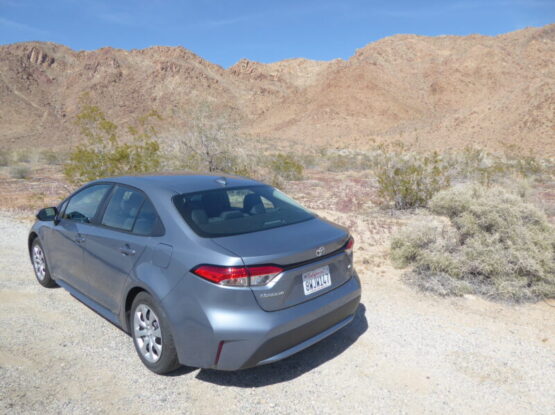After many years of renting cars in the US, I’ve got a pretty good idea of what is actually on the fleet, generally because I wander around even the largest of facilities before making a selection and going to ask if the car I have identified is available. In the post-Covid and chip supply times though, there have been some surprises, as Hertz like most rental car companies had to resort to buying a significant number of pre-owned cars simply to get the fleet to the size they needed to be able to match demand. That has meant some brands that do not usually feature being on offer, and indeed I have, in the last couple of years, been able to drive Lexus and Acura models for the first time. Many of these cars have now done their time, though and so the number of what you might call rental car oddities is reducing. But they are not entirely gone, as when I walked around the large LAX facility I found something I had not expected to, or which I had previously seen on the fleet at all, what you or I will think of as a VW Golf GTi, but which in America loses the Golf tag and is just branded VW GTi. I really hoped that it would prove available, and my luck was in, as it seemed no-one else knew about it, either.
The second surprise of the morning was that the car was labelled as a Group B, the same class that would get you a Nissan Versa, or if you were really unlucky, a Mitsubishi Mirage. Since Hertz in the US largely categorise cars on size and interior room, and the regular Golf hatch, a few of which have been on fleet in recent years, is also in group B, I guess this makes sense, but this is a much more costly car than the usual economy special that you would get when booking at this end of the rental market. I could see that this was a Mark 7.5 Golf, and once it was mine and I had the paperwork, I found out that it was in fact a 2020 model year. The Mark 7.5 lived on in the US for the 2021 model year as well, before the Mark 8 arrived for 2022. During the last four years of production, there were only minor trim and equipment changes.
To enthusiasts, the Golf GTi really won’t need much of an introduction. First seen in 1975 when the result of a sort of skunk works car attracted far attention than anyone in VW had expected, there have been performance versions of VW’s massive-selling family hatch ever since. They have kept pace with the evolution of the underlying Golf, generally appearing a few months after the launch of the cooking versions. Of course the GTi is no longer the Top Dog in the range, that honour going to the R model which goes back to the fifth generation, but for many that car is a bit too extreme and bit too costly whereas the sweet spot of the GTi has always been that it provides pretty much the perfect match between all the attributes of a very capable family car with just the right amount of extra fun added in for those occasions when something more than practical shopping or commuting transport is desired. The seventh generation Golf was launched at the 20212 Paris Auto Show and the GTi version arrived a few months later, though it took until the 2015 model year to reach America. It was immediately praised by the press pretty much the world over. Would it impress me as well?
There have been a number of limited edition cars based on the standard GTi during the life of the seventh generation model, such as the Clubsport, Clubsport S and TCR, all with a little more power and some other changes to make them that bit sharper to drive, but at quite a price premium. The standard car uses the 2.0 litre EA888 engine putting out 228PS, and it is offered coupled up to either a six speed manual or a 7 speed automatic transmission. Like all US rental cars, my test vehicle had the latter. There is a really satisfying roar on start up which give the indication that this going to prove to be that bit special. And it certainly is. Whilst 220 PS might not sound a lot in this day and age, especially when you look at the weight of new cars, it is precisely twice the output of that first Golf GTi, so it is not unreasonable to assume that this will retain the eager acceleration that made that initial car such a blast to drive. And so it proves. That initial roar sound continues when you accelerate, but it is not so much as to be wearing. The raw acceleration stats are actually not that special, but the turbocharged inline-four feels much stronger than the 7.1-second 0-60 mph time would suggest. There’s lots of smooth low-end torque, so you don’t need to downshift more than one gear to pass on the highway or power out of a corner. All this combined leaves you feeling that acceleration in this car to be always extremely impressive. It always feels eager, and rapid. The gearbox is well matched and makes almost rapid gearchanges which you can just detect as the noise level changes momentarily. There are paddles if you want to change the gears yourself, but I found that the ‘box could it more smoothly than I could. The GTi is not perhaps the quietest of cars when at a steady speed on the freeway, as whilst the engine note is quite subdued, there is plenty of road noise, but this is not so bad as to be something you could not live with. I covered exactly 329 miles in my time with the car and put 6.6 US gallons in it to fill it during the day, well east of LA where fuel is notably cheaper having covered 200 miles and a further 3.0 gallons just before returning it. That works out at 30.3 and 43.0 mpg US respectively, making me wonder just how full the car really was on collection, as that is such a massive difference between the two figures. There is a Stop/Start system which worked pretty well.
It’s not just the raw performance that makes the Golf GTi fun to drive, but also the combination of steering and handling. The GTi may have gained a lot in size and weight in those seven generations but it still feels like a large go-kart. The steering is beautifully weighted, so there is plenty of feel at all times, light when parking but needing that bit more effort as your turn the wheel. The handling is outstanding, too, with this car almost begging you to find the twisty roads. There is negligible body roll and masses of grip, thanks no doubt to the fact that a limited slip diff is now standard on all models. so this really is a joy to drive on the less than straight roads that are in shorter supply in the US than in Europe. There is a price to pay for this, though: the ride. This is firm to the point that you feel pretty much every bump and ridge and there are a lot of those on California’s roads. Thankfully, there were no issues with the brakes, though I did not have to put then to the ultimate test. There is a traditional pull-up handbrake fitted between the seats. All-round visibility is generally good, with a Blind Spot Warning system proving helpful when on the freeway and the rear-view camera makes backing up an easy task. VW added a number of the latest ADAS and safety features for the 2020 model year but these proved less intrusive than on most new cars.
The Golf has always been a nicely finished car inside. Whilst the early cars were quite austere, over the years, they have become more plush with a lot of added equipment as standard. VW use some good quality materials which appeal to both the eye and the touch. There is a leather-wrapped steering wheel which is good to hold and this features the red stitching that is one of the ways you tell a sporting Golf apart from the lesser models. The dash layout is very similar to that of the rest of the range. There is a simple instrument cluster with two large dials for speedometer and rev counter. The former has both mph and km/h markings in it making it look a little bust but there is a digital repeater to help out. Water temperature and fuel level gauges are inset in the lower portion of the main dials. There is a trip computer display area between the dials and you can cycle through many different options as is the VW Group way. The two column stalks are ones you will recognise from almost any current VW Group car. Lights operate from a rotary dial on the dash to the left of the wheel. The infotainment screen is integrated into the centre of the dash and again will be familiar from other models in the range. It always frustrates me when you get a selection option for navigation only to get the message saying “not installed”, as was the case here, but VW are far from the only culprits for this. Services you do get include XM Satellite radio, Apple Car Play and Android Auto and there is a Fender sound system, but there is only a single USB port which is a bit of a surprise these days. The user interface for the touch screen is pretty intuitive and the system responds well. There are some knobs and buttons for the unit as well as its touch interface. Beneath this are three rotaries and some buttons for the dual zone climate control and this system worked well, blowing cold and cooling the GTi down quickly. Vents for rear-seat passengers are a bonus. Overall, the layout is easy to use and unfussy, something that is become increasingly rare these days.
The test car was in Autobahn spec, the top version of the US range and it, like the middle version comes with leather upholstery and there is some of the red stitching which has been a feature of the GTi since launch but you do have to forego the plaid tartan trim that featured right back at the beginning of the GTi story and is still available in entry level S trim cars now. Adjustment for the driver’s seat is all-electric, over quite a wide range, and there are both height adjustable belts and a telescoping steering wheel, so getting comfortable was not hard. Although there is a standard sun roof include in the spec, there is still ample headroom and indeed there is a feeling space with ample leg and shoulder room, too. Seat heating is also included. The seat proved firm and supportive, with bolstering that did not feel overly snug.
Whilst the Golf is what many would think of as true family car, space in the rear seats is not overly generous. Really, this is better suited for two not least because the central console unit comes well back and there is a notable central tunnel. Whilst access through relatively short rear doors is good, if the front seats are well forward, legroom is ample, but it can get a bit tight if those seats are at the rearmost of their travel. There is a drop-down armrest with cup holders in the upper surface and for odds and ends there are both pockets on the doors and nets on the back of the front seats.
The boot seemed quite modest, too, though it is a nice regular shape and thankfully, there is a load cover. Under the floor there is a space saver which fills all the available space. The rear seats backrests are asymmetrically split and simply drop down to create a much longer load platform. Inside the cabin, there is a huge glovebox a small lidded cubby over the driver’s left knee, a small central armrest cubby as well as large door pockets, which should mean that most will find ample space to store bits and pieces.
With the short-lived Rabbit Edition no longer offered, for the US market, Volkswagen made the 2020 GTI in three trim levels: S, SE, and Autobahn. All three come with a turbocharged four-cylinder engine and either a six-speed manual or a seven-speed automatic transmission. The base S trim is well-equipped, but you’ll have to get the SE or Autobahn for a larger touch screen or comfort upgrades like leather seats. On the S, standard features include a 6.5-inch touch screen, Apple CarPlay, Android Auto, MirrorLink, a USB port, Bluetooth, a six-speaker stereo, a Wi-Fi hot spot, heated front seats, alloy wheels, forward collision warning, forward automatic emergency braking, pedestrian detection, blind spot monitoring, rear cross traffic alert, and a rearview camera. The SE gains leather seats, a sunroof, proximity keyless entry, an 8-inch touch screen, satellite radio, and HD Radio. The top-of-the-line Autobahn adds dual-zone automatic climate control, a power-adjustable driver’s seat, adaptive suspension dampers, lane keep assist, lane departure warning, front and rear parking sensors, adaptive cruise control, parallel and perpendicular park assist, navigation, and a Fender premium stereo.
My expectations for this car were very high, and I am pleased to report that I was not disappointed. I absolutely loved it. It really is not hard to see the appeal of the Golf GTi even after all these years as it really does combine everything you need in a practical family car with attributes which will just make you want to go and drive it for the sake of enjoyment. Yes, the ride is a bit firm, but otherwise, there really are no downsides, and the price premium both for purchase and running costs make this more realistic for a lot of people compared to the more extreme Golf R (no longer available in the US market, anyway). I have a feeling that this may be “Peak Car”. The Mark 7.5 was replaced by the Mark 8, phased in between 2020 and 2022, and no-one apart from VW has said that this is a better car, with its unfortunate looks and truly hateful capacity touch-screen interfaces. So go and enjoy this one while you can. Whether there are any more of them in the Hertz US fleet, I don’t know, but if there are, go get one now. To be able to get it for the same price as a Versa or a Mirage is even more of a bargain than the true cost of the car.

































































































































